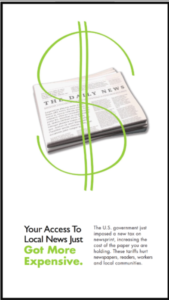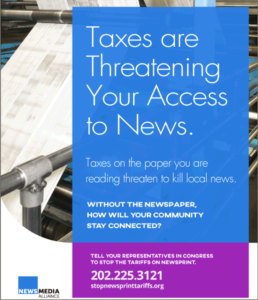Star Tribune Touts Higher Taxes–Except for Newspapers
 A full-page ad warning readers their “access to local news just got more expensive” has popped up again in the Star Tribune.
A full-page ad warning readers their “access to local news just got more expensive” has popped up again in the Star Tribune.
Higher U.S. tariffs imposed by the Trump Administration on Canadian newsprint used by most U.S. publishers threaten the industry’s bottom line, including the Star Tribune’s.
A trade group called the News Media Alliance takes responsibility for the ad’s ominous tone imploring news junkies to “protect your right to read.”
The notice even implores readers to urge their representatives in Congress to kill the tax.
The U.S. government just imposed a new tax on newsprint, increasing the cost of the paper you are holding. These tariffs hurt newspapers, readers, workers and local communities. (Editor’s note: Aren’t all communities “local”?)
Other versions of the national ad campaign paint a dark picture of an America deprived of local news sources. All because of higher taxes on the fourth estate!
The cross border skirmish has provided a crash course in supply and demand in newsrooms nationwide.
The Alliance says the government is now collecting these duties at the border, and Canadian manufacturers are already passing these new taxes on to newspapers.
“The Alliance has heard these tariffs have driven up newsprint prices by 20 to 30 percent. Newsprint supplies have tightened and some newspapers are being told that orders cannot be met,” it said in an e-mail.
Could it be the newspaper business has gotten religion on taxes? The AP notes the tariff comes at the worst possible time for an industry still struggling after a decade of steep declines in readership and advertising.
A large metro newspaper can expect annual increases of about $3 million in printing costs, according to Paul Boyle, senior vice president for the News Media Alliance. While larger papers might be able to survive the increase, Boyle said smaller publications might not.
Of course, the Star Tribune editorial board has rarely met a tax increase it failed to embrace. During the recent 2018 legislative session, the paper recommended lawmakers increase transportation taxes and suggested throwing families and businesses under the bus over the issue of tax conformity.
But with its own interests on the line, the paper opined against the so-called newsprint tax before it even went into effect in January.
The new duties will range from 4 to 10 percent — still a substantial bite that will be widely felt, since Canada is the world’s largest exporter of the uncoated groundwood paper used to produce newspapers, books and other paper goods, with U.S. imports of $1.27 billion in 2016. And the bite could get bigger.
As one of the most successful big city papers in the country, the Strib should be able to absorb the increased cost of doing business from the tariff more than smaller publications. That’s often the liberal rationale for endorsing tax hikes aimed at other entities. Yet in a recent interview by Poynter Institute, the Star Tribune’s publisher acknowledged even big corporations feel the financial hit.
Given the continued reliance on print, I asked if the Star Tribune is being burned by the increased tariffs on Canadian newsprint, running as high as 30 percent. The paper has a different mix of suppliers than some feeling the brunt of the tariffs but has seen prices rise, too, Klingensmith said. So far, that is being handled by some reductions in the size of print papers and more sparing use of in-paper promos rather than by layoffs.
Perhaps this dose of economic reality will prompt a change of thinking at the paper. On the other hand, this week the Strib castigated lawmakers’ failure to impose a politically expedient $20 million tax, disguised as a “registration fee,” aimed at drug companies that became soft targets due to the opioid crisis.
All of which suggests it may require another increase in the newsprint tariff to get the Strib to start applying the paper’s self-serving views on higher taxes for newspapers to everyone else, as well.